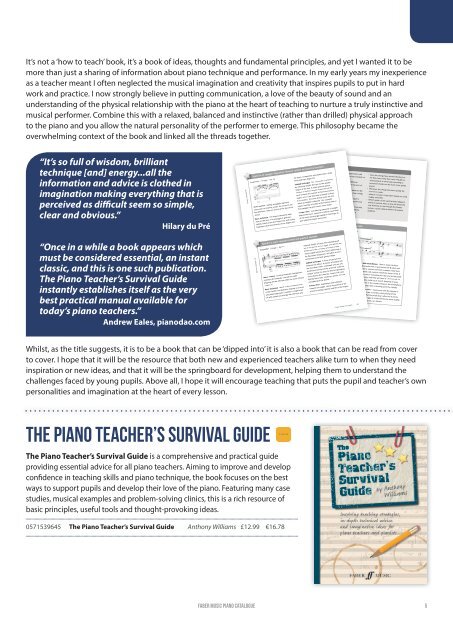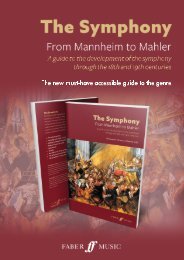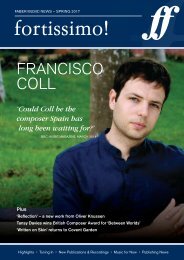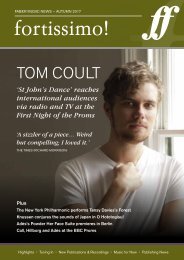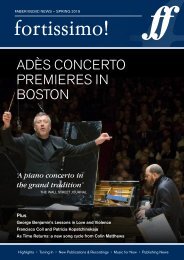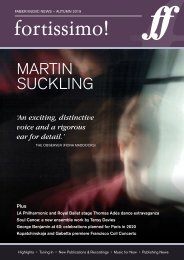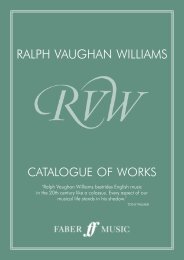Piano Catalogue
We’re extremely proud of our rich tradition of high-quality piano music and are constantly adding new and exciting publications to the list. We’ve created the Faber Music Piano Catalogue to help you to explore our extensive catalogue. We hope that this resource will help you find out more about the titles you already know, and highlight those hidden gems or new publications that you may not have come across before. And because we wanted to give you more than a catalogue, we’ve incorporated some elements from our popular Pianofforte to provide some extra insight from our composers and authors.
We’re extremely proud of our rich tradition of high-quality piano music and are constantly adding new and exciting publications to the list. We’ve created the Faber Music Piano Catalogue to help you to explore our extensive catalogue. We hope that this resource will help you find out more about the titles you already know, and highlight those hidden gems or new publications that you may not have come across before. And because we wanted to give you more than a catalogue, we’ve incorporated some elements from our popular Pianofforte to provide some extra insight from our composers and authors.
You also want an ePaper? Increase the reach of your titles
YUMPU automatically turns print PDFs into web optimized ePapers that Google loves.
It’s not a ‘how to teach’ book, it’s a book of ideas, thoughts and fundamental principles, and yet I wanted it to be<br />
more than just a sharing of information about piano technique and performance. In my early years my inexperience<br />
as a teacher meant I often neglected the musical imagination and creativity that inspires pupils to put in hard<br />
work and practice. I now strongly believe in putting communication, a love of the beauty of sound and an<br />
understanding of the physical relationship with the piano at the heart of teaching to nurture a truly instinctive and<br />
musical performer. Combine this with a relaxed, balanced and instinctive (rather than drilled) physical approach<br />
to the piano and you allow the natural personality of the performer to emerge. This philosophy became the<br />
overwhelming context of the book and linked all the threads together.<br />
“It’s so full of wisdom, brilliant<br />
technique [and] energy...all the<br />
information and advice is clothed in<br />
imagination making everything that is<br />
perceived as difficult seem so simple,<br />
clear and obvious.”<br />
Hilary du Pré<br />
[Music example 9]<br />
Speed in an arpeggio figuration: Musical context and practical example<br />
Burgmüller: L’Orage 1, , bar 10<br />
Music context Rolling arpeggios represent<br />
heavy seas or howling winds; the accent is not<br />
too definitive, more an arrival at the top of the<br />
phrase.<br />
Basic technique The fingers should be kept<br />
close to the keys. The arpeggio is gestural,<br />
slightly rolled across the fingers but with active<br />
fingertips (small movements of the fingers into<br />
the keys). It should be articulated with a static<br />
hand and high finger-lift.<br />
Teaching effect pedal<br />
Refined technique The crescendo is achieved<br />
by releasing weight through to the weaker<br />
fingers at the top. A more gestural action<br />
involves a vertical circular movement of the<br />
wrist towards the outside of the hand (which<br />
begins before the first note is played so there<br />
is no accent). The wrist should come up and<br />
round as weight is released. Use a greater<br />
legato (overlap of notes) at the bottom end of<br />
the arpeggio to give it even more shape.<br />
Further ideas Use differing amounts of weight<br />
behind the hand, amounts of lateral movement<br />
of the wrist and energy (speed) in the finger to<br />
give different shapes and sound.<br />
Place the pedal down and experiment with • Once the strings have started vibrating on<br />
the sonorities using some free improvisation or the first chord, they then need virtually no<br />
reinforcement at all to keep sounding so<br />
Experiment with the effect of different<br />
successive chords can be much more gently<br />
dynamics, registers and even the balance of placed.<br />
• The lower the strings the more quickly the<br />
Notice the significant difference between the resonance builds.<br />
sustaining properties of the lower bass strings • Balance is crucial. Project the melody to avoid<br />
muddy sonorities.<br />
Put the pedal down and by repeating the • ‘Effect’ pedal can be used to blend adjacent<br />
same chord, create the effect of a continuous chords in various ways; a slow lift allows the<br />
new harmony to rise through the blurred<br />
The instinct will be to play a series of similarly texture, a quick release allows it to appear<br />
weighted chords, but you’ll notice that the suddenly.<br />
sound builds very quickly through each<br />
Simple effect pedal: practical example<br />
, bars 42 to 44<br />
“Once in a while a book appears which<br />
must be considered essential, an instant<br />
classic, and this is one such publication.<br />
The <strong>Piano</strong> Teacher’s Survival Guide<br />
instantly establishes itself as the very<br />
best practical manual available for<br />
today’s piano teachers.”<br />
Andrew Eales, pianodao.com<br />
[Music example 10]<br />
Speed in a scale: musical context and practical example<br />
Burgmüller: L’Orage 2, bar 14<br />
reduced weight will give the notated result<br />
but it will not be a true legato and will be too<br />
brittle and scalic. A lower wrist and a little<br />
initial weight behind the hand, lightening as<br />
the figuration progresses, will allow a more<br />
connected sound and greater shape.<br />
Refined technique A sense of gesture will<br />
enhance the effect. A release of weight into<br />
the first three notes, combined with an anticlockwise<br />
lowering of the wrist will ‘walk the<br />
Music context Exciting chromatic semiquavers<br />
represent the dramatic cascade of water<br />
weight’ across the keys for the first grouping<br />
dripping off the cliff face after the wave (chord) and enhance the sonority. Fingers will need<br />
crashes in.<br />
slightly more time, creating a subtle ritenuto<br />
and adding to the drama.<br />
Basic technique Much of the excitement lies<br />
in the rhythm and dynamic shaping so a more Further ideas Experiment with different<br />
articulated approach is needed. A high finger amounts of weight, lateral movement of the<br />
lift with speed and energy into the keys and wrist and energy (speed) and lift in the fingers.<br />
Finger speed and agility<br />
footer<br />
63<br />
Refined technique There is scope to place<br />
the pedal with or just before the B which will<br />
give a warmer and more rounded initial tone.<br />
Chords will need to match the decay of the B<br />
for a more evocative third bar and as the pedal<br />
is being held they will need to decrescendo to<br />
avoid a build-up of sound. Keeping an even<br />
balance in the chords enhances the atmosphere<br />
and stops them intruding upon the melody.<br />
Further ideas Experiment with the degree of<br />
tone on the B and the initial placing of the<br />
pedal. Put the pedal down after the B and try<br />
different speeds of descent to see what audible<br />
difference you can discern.<br />
Whilst, as the title suggests, it is to be a book that can be ‘dipped into’ it is also a book that can be read from cover<br />
to cover. I hope that it will be the resource that both new and experienced teachers alike turn to when they need<br />
inspiration or new ideas, and that it will be the springboard for development, helping them to understand the<br />
challenges faced by young pupils. Above all, I hope it will encourage teaching that puts the pupil and teacher’s own<br />
personalities and imagination at the heart of every lesson.<br />
The <strong>Piano</strong> Teacher’s Survival Guide<br />
The <strong>Piano</strong> Teacher’s Survival Guide is a comprehensive and practical guide<br />
providing essential advice for all piano teachers. Aiming to improve and develop<br />
confidence in teaching skills and piano technique, the book focuses on the best<br />
ways to support pupils and develop their love of the piano. Featuring many case<br />
studies, musical examples and problem-solving clinics, this is a rich resource of<br />
basic principles, useful tools and thought-provoking ideas.<br />
0571539645 The <strong>Piano</strong> Teacher’s Survival Guide Anthony Williams £12.99 €16.78<br />
Faber Music <strong>Piano</strong> <strong>Catalogue</strong><br />
5


